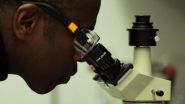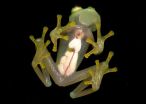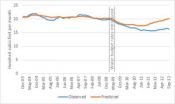(Press-News.org) Philadelphia, PA, February 20, 2014 – Schizophrenia has long been known to be highly heritable and is present in approximately 1% of the population. Researchers have been following two paths in their pursuit of identifying schizophrenia risk genes.
Initially, they studied common gene variants that, individually, only increase the risk for schizophrenia by a few percent, perhaps increasing the likelihood of developing schizophrenia from a 10 out of a 1000 chance to an 11 or 12 out of a 1000 chance.
More recently, research has identified gene variants that are rare in the population but, when present, more substantially increase the risk for developing schizophrenia. For example, in the current issue of Biological Psychiatry, a large collaborating group of international scientists, led by Dr. Jennifer Mulle, an Assistant Professor at Emory, report a 1.4 megabase duplication on chromosome 7 (7q11.23) that increases the risk for schizophrenia over 10 times, i.e., to 100 out of a 1000 chance (10%).
"We also found it interesting that three different disorders (schizophrenia, autism, and intellectual development) that strike at different times and present in different ways, have genetic links to this same region on chromosome 7," commented Mulle. "Our findings support the notion of a neuro-developmental link between these disorders."
In this same issue, Dr. George Kirov at Cardiff University and colleagues scanned the genome for copy number gene variants, i.e., where abnormal numbers of gene copies exist. They studied 70 of these variants, all previously implicated in schizophrenia and/or early-onset developmental disorders, such as developmental delay, intellectual deficit and autism spectrum disorders (DD/ID/ASD). They then compared the risk for carriers of these variants to develop one or more of these disorders, i.e. their genetic penetrance.
"The result might be unexpected for many: the penetrance for schizophrenia is several times lower than for the group of DD/ID/ASD. The total penetrance for any of these disorders is quite high, ranging from 10% for duplications at 16p13.11 to nearly 100% for the velocardiofacial syndrome region on chromosome 22. These findings will have implications for genetic counselling of carriers," said Kirov.
"It seems that we are at a critical point in the genetics of schizophrenia – the identification of rare gene variants that substantially increase the risk for schizophrenia," said Dr. John Krystal, Editor of Biological Psychiatry. "However, we have a very limited understanding of how these genes alter brain development to produce schizophrenia and other disorders. This knowledge would seem to hold clues about mechanisms of prevention and treatment."
In addition, scientists do not yet understand why the genetics of schizophrenia is not tightly aligned with the symptoms of schizophrenia. In other words, gene variants that increase the risk for schizophrenia increase the risk for other disorders, such as developmental delay, autism, and bipolar disorder.
"The failure of our genome to follow DSM-V is not simply a shortcoming of our diagnostic manual, rather it is yet another reminder that there are fundamental aspects of the biology of psychiatric disorders that we do not understand," added Krystal.
INFORMATION:
The articles are "Reciprocal Duplication of the Williams-Beuren Syndrome Deletion on Chromosome 7q11.23 Is Associated with Schizophrenia" by Jennifer Gladys Mulle, Ann E. Pulver, John A. McGrath, Paula S. Wolyniec, Anne F. Dodd, David J. Cutler, Jonathan Sebat, Dheeraj Malhotra, Gerald Nestadt, Donald F. Conrad, Matthew Hurles, Chris P. Barnes, Masashi Ikeda, Nakao Iwata, Douglas F. Levinson, Pablo V. Gejman, Alan R. Sanders, Jubao Duan, Adele A. Mitchell, Inga Peter, Pamela Sklar, Colm T. O'Dushlaine, Detelina Grozeva, Michael C. O'Donovan, Michael J. Owen, Christina M. Hultman, Anna K. Kähler, Patrick F. Sullivan, The Molecular Genetics of Schizophrenia Consortium, George Kirov, and Stephen T. Warren (doi: 10.1016/j.biopsych.2013.05.040) and "The Penetrance of Copy Number Variations for Schizophrenia and Developmental Delay" by George Kirov, Elliott Rees, James T.R. Walters, Valentina Escott-Price, Lyudmila Georgieva, Alexander L. Richards, Kimberly D. Chambert, Gerwyn Davies, Sophie E. Legge, Jennifer L. Moran, Steven A. McCarroll, Michael C. O'Donovan, and Michael J. Owen (doi: 10.1016/j.biopsych.2013.07.022). The articles appear in Biological Psychiatry, Volume 75, Issue 5 (March 1, 2014), published by Elsevier.
Notes for editors
Full text of the article is available to credentialed journalists upon request; contact Rhiannon Bugno at +1 214 648 0880 or Biol.Psych@utsouthwestern.edu. Journalists wishing to interview the authors may contact Dr. Jennifer Mulle at +1 404 727 0406 or jmulle@emory.edu and George Kirov at +44 29 20 688 465 or kirov@cardiff.ac.uk.
The authors' affiliations, and disclosures of financial and conflicts of interests are available in their respective articles.
John H. Krystal, M.D., is Chairman of the Department of Psychiatry at the Yale University School of Medicine, Chief of Psychiatry at Yale-New Haven Hospital, and a research psychiatrist at the VA Connecticut Healthcare System. His disclosures of financial and conflicts of interests are available here.
About Biological Psychiatry
Biological Psychiatry is the official journal of the Society of Biological Psychiatry, whose purpose is to promote excellence in scientific research and education in fields that investigate the nature, causes, mechanisms and treatments of disorders of thought, emotion, or behavior. In accord with this mission, this peer-reviewed, rapid-publication, international journal publishes both basic and clinical contributions from all disciplines and research areas relevant to the pathophysiology and treatment of major psychiatric disorders.
The journal publishes novel results of original research which represent an important new lead or significant impact on the field, particularly those addressing genetic and environmental risk factors, neural circuitry and neurochemistry, and important new therapeutic approaches. Reviews and commentaries that focus on topics of current research and interest are also encouraged.
Biological Psychiatry is one of the most selective and highly cited journals in the field of psychiatric neuroscience. It is ranked 4th out of 135 Psychiatry titles and 13th out of 251 Neurosciences titles in the Journal Citations Reports® published by Thomson Reuters. The 2012 Impact Factor score for Biological Psychiatry is 9.247.
About Elsevier
Elsevier is a world-leading provider of scientific, technical and medical information products and services. The company works in partnership with the global science and health communities to publish more than 2,000 journals, including The Lancet and Cell, and 25,000 book titles, including major reference works from Mosby and Saunders. Elsevier's online solutions include ScienceDirect, Scopus, SciVal, Reaxys, ClinicalKey and Mosby's Suite, which enhance the productivity of science and health professionals, helping research and health care institutions deliver better outcomes more cost-effectively.
A global business headquartered in Amsterdam, Elsevier employs 7,000 people worldwide. The company is part of Reed Elsevier Group PLC, a world leading provider of professional information solutions in the Science, Medical, Legal and Risk and Business sectors, which is jointly owned by Reed Elsevier PLC and Reed Elsevier NV. The ticker symbols are REN (Euronext Amsterdam), REL (London Stock Exchange), RUK and ENL (New York Stock Exchange).
Media contact
Rhiannon Bugno
Editorial Office
+1 214 648 0880
Biol.Psych@utsouthwestern.edu
Gathering the clues to rare gene variants contributing to schizophrenia
Findings from 2 new studies in Biological Psychiatry
2014-02-20
ELSE PRESS RELEASES FROM THIS DATE:
Spotlighting black chemists and chemical engineers (video)
2014-02-20
WASHINGTON, Feb. 20, 2014 — Their research may lead to a new generation of renewable fuels, medical devices and safer home products. The American Chemical Society (ACS) is continuing its celebration of Black History Month with a new video featuring several African-American chemists and chemical engineers doing cutting edge research today. The video is available at http://youtu.be/v0PmKbJNAQI.
The video, produced with the National Organization for the Professional Advancement of Black Chemists and Chemical Engineers (NOBCChE), highlights the efforts of Kristala Prather, ...
High cost of fruits, vegetables linked to higher body fat in young children
2014-02-20
Washington, D.C.--High prices for fresh fruits and vegetables are associated with higher Body Mass Index (BMI) in young children in low- and middle-income households, according to American University researchers in the journal Pediatrics.
"There is a small, but significant, association between the prices of fruit and vegetables and higher child BMI," said Taryn Morrissey, the study's lead author and assistant professor of public administration and policy at AU's School of Public Affairs (SPA).
Morrissey said that when the prices of fruits and vegetables go up, families ...
Cell behavior in low oxygen conditions mapped
2014-02-20
LIVERPOOL, UK – 17 February 2014: Research at the University of Liverpool has explained how cells behave when placed in a low oxygen environment, a development that could have implications for cancer patients and other serious illnesses.
The research opens up the possibility of controlling the signals that keep cells alive, preventing the damages caused by ischemia – a restriction of blood supply to tissues. It could also work to help destroy cancer cells.
When the body is deprived of adequate oxygen supply it is known as hypoxia and can cause the death of cells. This ...
Astronomers find solar storms behave like supernovae
2014-02-20
Researchers at UCL have studied the behaviour of the Sun's coronal mass ejections, explaining for the first time the details of how these huge eruptions behave as they fall back onto the Sun's surface. In the process, they have discovered that coronal mass ejections have a surprising twin in the depths of space: the tendrils of gas in the Crab Nebula, which lie 6500 light-years away and are millions of times larger.
On 7 June 2011, the biggest ejection of material ever observed erupted from the surface of the Sun. Over the days that followed, the plasma belched out ...
High potency statins linked to better outcome following a heart attack
2014-02-20
A study looking at the data of thousands of patients who suffered heart attacks has suggested treatment with high-potency statins offers a significantly improved chance of survival compared to those taking normal statins.
The study, led by the University of Dundee, also found a combination of statins and the drug ezetimibe showed no improved survival rate, although researchers caution this finding needs further testing.
"There is presently a lot of interest in ezetimibe as a potential treatment for heart patients," said Professor Chim Lang, from the Division of Cardiovascular ...
Mistaken point, Sanctuary of Zeus, catastrophic outburst floods, shocked sand grains
2014-02-20
Boulder, Colo., USA – GSA Bulletin postings for February cover the sculpting of Earth's surface as seen in the Pyrenees; facies architecture in Washington State, USA; atmospheric circulation recorded in the Permian Maroon Formation; preglacial fluvial gorges and valleys; banded iron formations; paleosols in Wapadsberg Pass, South Africa; Ediacaran fossils from Mistaken Point, Newfoundland; geologic forensics and sedimentary fingerprints; catastrophic outburst floods recorded in the Tibetan Plateau; the Sudbury impact structure, Canada; and observations at the Sanctuary ...
Aging men: More uplifts, fewer hassles until the age of 65-70
2014-02-20
CORVALLIS, Ore. – A new study of how men approach their golden years found that how happy individuals are remains relatively stable for some 80 percent of the population, but perceptions of unhappiness – or dealing with "hassles" – tends to get worse once you are about 65-70 years old.
The reasons vary, researchers say, but may be because of health issues, cognitive decline or the loss of a spouse or friends.
"In general, life gets better as you age in the sense that older adults on average have fewer hassles – and respond to them better – than younger adults," said ...
Rocks around the clock: Asteroids pound tiny star
2014-02-20
Scientists using the Australian Commonwealth Scientific and Industrial Research Organisation's (CSIRO) Parkes telescope and another telescope in South Africa have found evidence that a tiny star called PSR J0738-4042 is being pounded by asteroids — large lumps of rock from space.
"One of these rocks seems to have had a mass of about a billion tonnes," CSIRO astronomer and member of the research team Dr Ryan Shannon said.
PSR J0738-4042 lies 37,000 light-years from Earth in the constellation of Puppis.
The environment around this star is especially harsh, full of radiation ...
Peru's Manu National Park sets new biodiversity record
2014-02-20
Peru's treasured Manu National Park is the world's top biodiversity hotspot for reptiles and amphibians, according to a new survey published last week by biologists from the University of California, Berkeley, Southern Illinois University in Carbondale (SIU-Carbondale) and Illinois Wesleyan University.
The park, which encompasses lowland Amazonian rain forest, high-altitude cloud forest and Andean grassland east of Cuzco, is well known for its huge variety of bird life, which attracts ecotourists from around the globe. More than 1,000 species of birds, about 10 percent ...
An innovative approach to promote water use efficiency
2014-02-20
RIVERSIDE, Calif. — Increasing block-rate water budgets are an innovative type of escalating tiered price structure in which the consumption block sizes are based on household characteristics, environmental conditions, and a judgment by the water utility with regard to what constitutes "efficient" water use given those characteristics and conditions.
In these water budgets, prices are set relatively low for the most essential uses of water but then increase with usage. The price structure more accurately reflects the cost of supplying water and thus sends a more appropriate ...
LAST 30 PRESS RELEASES:
Numbers in our sights affect how we perceive space
SIMJ announces global collaborative book project in commemoration of its 75th anniversary
Air pollution exposure and birth weight
Obstructive sleep apnea risk and mental health conditions among older adults
How talking slows eye movements behind the wheel
The Ceramic Society of Japan’s Oxoate Ceramics Research Association launches new international book project
Heart-brain connection: international study reveals the role of the vagus nerve in keeping the heart young
Researchers identify Rb1 as a predictive biomarker for a new therapeutic strategy in some breast cancers
Survey reveals ethical gaps slowing AI adoption in pediatric surgery
Stimulant ADHD medications work differently than thought
AI overestimates how smart people are, according to HSE economists
HSE researchers create genome-wide map of quadruplexes
Scientists boost cell "powerhouses" to burn more calories
Automatic label checking: The missing step in making reliable medical AI
Low daily alcohol intake linked to 50% heightened mouth cancer risk in India
American Meteorological Society announces Rick Spinrad as 2026 President-Elect
Biomass-based carbon capture spotlighted in newly released global climate webinar recording
Illuminating invisible nano pollutants: advanced bioimaging tracks the full journey of emerging nanoscale contaminants in living systems
How does age affect recovery from spinal cord injury?
Novel AI tool offers prognosis for patients with head and neck cancer
Fathers’ microplastic exposure tied to their children’s metabolic problems
Research validates laboratory model for studying high-grade serous ovarian cancer
SIR 2026 delivers transformative breakthroughs in minimally invasive medicine to improve patient care
Stem Cell Reports most downloaded papers of 2025 highlight the breadth and impact of stem cell research
Oxford-led study estimates NHS spends around 3% of its primary and secondary care budget on the health impacts of heat and cold in England
A researcher’s long quest leads to a smart composite breakthrough
Urban wild bees act as “microbial sensors” of city health.
New study finds where you live affects recovery after a hip fracture
Forecasting the impact of fully automated vehicle adoption on US road traffic injuries
Alcohol-related hospitalizations from 2016 to 2022
[Press-News.org] Gathering the clues to rare gene variants contributing to schizophreniaFindings from 2 new studies in Biological Psychiatry



